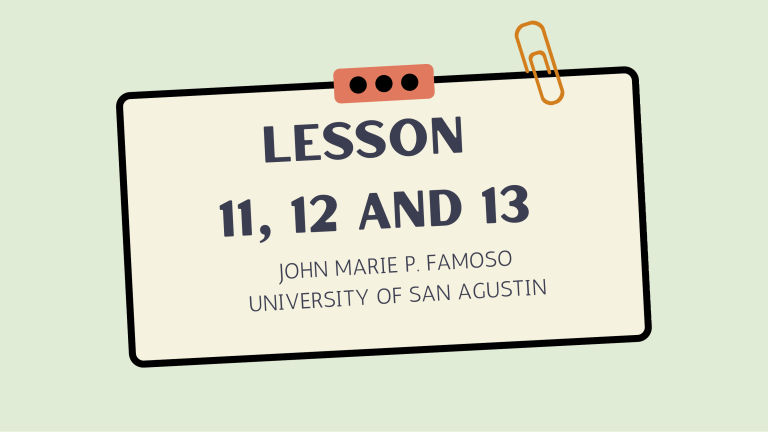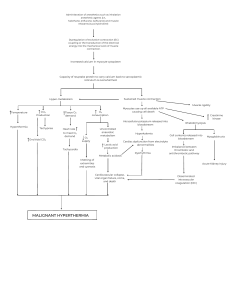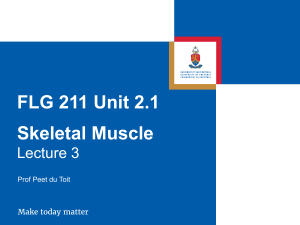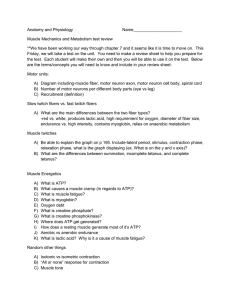
n o s s e L 3 1 d n a 11, 12 O S O M A F . P JOHN MARIE N I T S U G A N A S F O Y T I S R E V I N U mUSCLE STRUCTURE aCTION POTENTIAL 1. Resting Membrane Potential – state where the cell membranes have a negative charge on the inside relative to positive charge outside. This exists because of the following: NIPO higher concentration of K+ on the inside of cell membrane higher concentration of Na+ on the outside of cell membrane many negatively charged molecules inside the cell cell membrane is more permeable to K+ than Na+ ACTION POTENTIAL 2. Action Potential – brief reversal of the membrane charge that is carried rapidly along the cell membrane. NOPI Depolarization: change in charges where the Na+ channels open causing the sodium ions to enter the inside of the cell membrane (becomes more positive). This increase in positive charge changes the membrane potential to a value called threshold (weakest stimulus needed to produce a response). ACTION POTENTIAL 3. Repolarization: returns the cell to its resting membrane conditions & action potential ends. This occurs due to the exit of K+ from the cell & closing of Na+ channels that stops the sodium movement (NIPO). NERVE SUPPLY AND MUSCLE FIBER Motor Neurons – are specialized nerve cells that carry action potentials to skeletal muscles & stimulate to contract. Motor Unit – group of muscle fibers that motor neuron stimulates. Neuromuscular Junction / Synapse – where the neuron and muscle fibers meet; consists of several enlarged axon terminals (presynaptic terminal) resting in indentations of muscle fiber’s sarcolemma (postsynaptic membrane) Synaptic Vesicle – located in each presynaptic terminal that contains the neurotransmitter called acetylcholine (ACh) which stimulates or inhibits postsynaptic cells. NEUROMUSCULAR JUNCTION Acetylcholinesterase – an enzyme that breaks down the ACh to prevent overstimulation of muscle fibers. mUSCULAR CONTRACTION uSE OF atp FOR CONTRACTION Adenosine Triphosphate (ATP) – a high-energy molecule produced from the energy that is released during the metabolism of food which is used for muscle contraction; breaks down to adenosine diphosphate (ADP) & phosphate. ATP is stored in myosin heads ATP helps form cross-bridge formation between myosin and actin New ATP must bind to myosin before cross-bridge is released Rigor Mortis – stiffening of muscle fibers that occurs after death resulting from the influx of calcium ions into the sarcomere (no ATP is available to release cross-bridges) mUSCLE TWITCH a single contraction of muscle fiber in response to a stimulus and has 3 phases: Lag Phase / Latent Phase: time between the application of stimulus and beginning of contraction Contraction Phase: time during which the muscle contracts Tetany : sustained contraction, no relaxation due to constant stimulation Recruitment : number of muscle fibers stimulated increased by increasing number of motor units stimulated more force Relaxation Phase: time during which the muscle relaxes → 2 Ways in Increasing the Force of Muscle Contraction 1. Summation – individual muscles contract more forcefully through rapid stimulation of muscle fibers preventing relaxation or detachment of cross-bridges Tetanus: a sustained contraction that occurs when the frequency of stimulation is so rapid that no relaxation occurs 2. Recruitment – more motor units are stimulated which increases the total number of muscle fibers contracting All or None Law: no in between in muscle contraction, either the muscle contracts or does not With each subsequent stimulation, more crossbridges form due to Ca2+ buildup in myofibrils. The buildup of Ca2+ occurs because the rapid production of action potentials in muscle fibers causes Ca2+ to be released from the sarcoplasmic reticulum faster than it is actively transported back. One contraction summates, or is added onto, a previous contraction, increasing the overall force of contraction. 2 types of muscle fibers Humans have both types of fibers. Distribution of fibers is genetically determined. An active, healthy adult has an equal number of fastand slow-twitch fibers. Neither type can be converted but capacity can be increased through intense exercise. Energy Requirements for Muscle Contraction a. This energy comes from either aerobic (requires oxygen) or anaerobic (no need of oxygen) ATP production. 4 sources of atp 1. Aerobic production of ATP during most exercise and normal conditions breakdown of glucose in presence of oxygen to produce CO2, H2O, and approx. 36 ATP molecules. Lactate - produced by skeletal muscles all the time, especially during exercise (alternate chemical form of lactic acid) e.g. TCA/Krebs Cycle, Glycolysis, Citric Acid Cycle 2. Anaerobic production of ATP during intensive short-term work does NOT require oxygen; breaks down glucose to make 2 ATP & lactate (less efficient and accumulates toxins) 4 sources of atp 3. Conversion of a molecule called creatine phosphate to ATP 1 Creatine phosphate = 1 ATP + 1 Creatine – an energy-storage molecule from excess ATP which is broken down quickly to directly synthesize ATP in contracting muscle fibers 4. Conversion of two ADP to one ATP and one AMP (adenosine monophosphate) during heavy exercise FQ time! The ______ is the functional unit of skeletal muscle because it is the smallest portion capable of ___________. a. muscle fiber, receiving a stimulus b. muscle fiber, contracting c. sarcomere, contracting d. sarcomere, receiving a stimulus FQ time! All of the following describe the characteristics of acetylcholine, except: a. is the neurotransmitter at the neuromuscular junction. b. is broken down by acetylcholinesterase. c. binds to receptors on the presynaptic terminal. d. causes an influx of sodium ions into the muscle cell when bound to its receptor. FQ time! 1. The myosin myofilaments are anchored into the cytoskeleton of the cell by the __________. a. M line b. Z disks c. A band d. I band e. H zone FQ time! 1. Muscle fibers: (Select all that apply) a. have a relatively high metabolic rate b. depend upon large amounts of oxygen and carbon dioxide c. contain small numbers of mitochondria d. preferentially use aerobic respiration FQ time! Which of the following statements is FALSE? a. The resting potential of a cell develops because the cell membrane is more permeable to K+ than it is to most other ions. b. The concentration of Na+ is higher inside the cell than outside. c. Potassium ions only diffuse down their gradient until the charge difference across the membrane is great enough (electrical equilibrium) to prevent additional diffusion. d. Potassium's tendency to diffuse out is opposed by the attractive forces of the negative charge inside the cell. e. The sodium-potassium exchange pump maintains the normal resting concentrations of ions on either side of the cell membrane. FQ time! In a resting cell, K+ ions have a higher concentration ______ the cell, which results in the net movement of K+ _______ of the cell. a. inside; out b. outside; into c. inside; into d. outside; out FQ time! In skeletal muscle contraction and relaxation, calcium ions: a. bind to myosin myofilaments. b. are returned to the sarcoplasmic reticulum by active transport. c. are released from the T tubules by active transport. d. provide the energy for muscle contraction. e. have both bind to myosin myofilaments and are returned to the sarcoplasmic reticulum by active transport as normal properties. FQ time! Pepper has been exerting effort to push the wall as part of her exercise regimen in achieving good muscle tone. As a student, she knows that there is an increase in tension to muscles without changing its length. This type of contraction is: a. concentric b. isotonic c. eccentric d. isometric u o y Thank O S O M A F . P JOHN MARIE N I T S U G A N A S F O Y T I S R E V I N U






